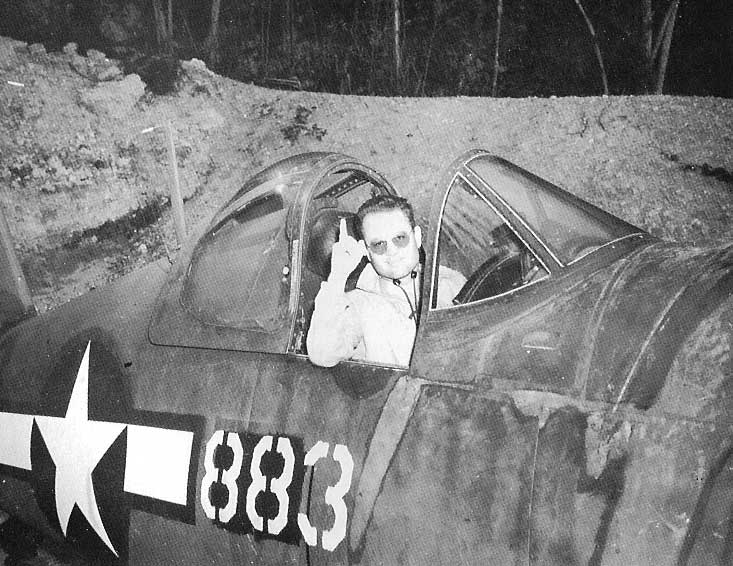 Gregory R. Boyington
was born in Coeur d'Alene, Idaho, in 1912, to parents of part
American Indian ancestry. His ambition to be a pilot began at
the age of eight, when he took his first airplane ride from the
famous Clyde Pangborn, who in 1931 became the first to fly non
stop from Japan to the U. S. To say Boyington was the most colorful
character to pin on the eagle, globe, anchor, and gold wings
would be an understatement. The partying, "tell it like
it is," irreverent, Boyington was loved by his subordinates
and contemporaries while being hated by some of his superiors.
Judging the way he lived, one might presume he got where he was
by clawing his way up the ranks the hard way. In fact, he graduated
with a degree in aeronautical engineering from the University
of Washington in 1934. He was a member of the Huskies swimming
and wrestling teams and one year was the Northwest Intercollegiate
middleweight wrestling champion. Following graduation, he served
briefly as a reserve officer in the Army's Coast Artillery before
joining Boeing Aircraft in Seattle as an aeronautical engineer.
Gregory R. Boyington
was born in Coeur d'Alene, Idaho, in 1912, to parents of part
American Indian ancestry. His ambition to be a pilot began at
the age of eight, when he took his first airplane ride from the
famous Clyde Pangborn, who in 1931 became the first to fly non
stop from Japan to the U. S. To say Boyington was the most colorful
character to pin on the eagle, globe, anchor, and gold wings
would be an understatement. The partying, "tell it like
it is," irreverent, Boyington was loved by his subordinates
and contemporaries while being hated by some of his superiors.
Judging the way he lived, one might presume he got where he was
by clawing his way up the ranks the hard way. In fact, he graduated
with a degree in aeronautical engineering from the University
of Washington in 1934. He was a member of the Huskies swimming
and wrestling teams and one year was the Northwest Intercollegiate
middleweight wrestling champion. Following graduation, he served
briefly as a reserve officer in the Army's Coast Artillery before
joining Boeing Aircraft in Seattle as an aeronautical engineer.
In February 1936, Boyington quit his job at Boeing and enrolled in the new Naval Cadet program. Although cadets were required to be single, the maverick Boyington was secretly married throughout flight training. He received his wings and commission on March 11, 1937 at Pensacola. He served with Aircraft One at Quantico before attending Basic School at Philadelphia. Boyington's next assignment was with VMF-2 at San Diego. As the best pilot in the squadron, he defeated the Navy's best pilot in the annual gun camera competition. He acquired the nickname "Rats" due to his resemblance to a cartoon character of the time called eneral Ratoff. Some of his old friends referred to him as "Rats" for the rest of his life.
Incredibly, Boyington had not received one major decoration up to his capture - his superior, Col. Lard, had not recommended him for any. The Army had tried to award him the Silver Star for defending Army bombers, but this was rejected by Marine higher ups who told the Army that the Marines were quite capable of decorating their own. No Americans had witnessed Boyington being shot down and he was reported as missing and presumed dead. He was posthumously awarded the Medal of Honor and the Navy Cross. Even that did not come until the Ed Sullivan radio show brought his exploits to the public's attention. Following the end of the war, Boyington was found alive in Japan. Enroute home, a special board promoted him to LCol. Back in the States, he went on an extensive Victory Bond Drive and received the Medal of Honor from President Harry Truman.
Boyington had four wives. One of his three children was an Air Force pilot who flew the F-4 Phantom in Viet Nam - a fact he was quite proud of. He was a great combat leader and pilot, remaining as the highest-ranking Marine ace of all time with 28 confirmed victories. Living his life out in Fresno, California Boyington died in 1988 and was buried at Arlington National Cemetery near the Tomb of the Unknown Soldier. In the final line of Baa Baa Black Sheep he wrote: "If this story were to have a moral, then I would say: `Just name a hero and I'll prove he's a bum.' " That statement could not have been further from the truth.